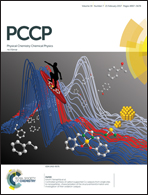Heat of capillary condensation in nanopores: new insights from the equation of state†
Abstract
Perturbed-Chain Statistical Associating Fluid Theory (PC-SAFT) coupled with the Young–Laplace equation is a recently developed equation of state (EOS) that successfully presents not only the capillary condensation but also the pore critical phenomena. The development of this new EOS allows further investigation of the heats involved in condensation. Compared to the conventional approaches, the EOS calculations present the temperature-dependent behavior of the heat of capillary condensation as well as that of the contributing effects. The confinement effect was found to be the strongest at the pore critical point. Therefore, contrary to the bulk heat condensation that vanishes at the critical point, the heat of capillary condensation in small pores shows a minimum and then increases with temperature when approaching the pore critical temperature. Strong support for the existence of the pore critical point is also discussed as the volume expansivity of the condensed phase in confinement was found to increase dramatically near the pore critical temperature. At high reduced temperatures, the Clausius–Clapeyron equation was found to apply better for confined fluids than it does for bulk fluids.



 Please wait while we load your content...
Please wait while we load your content...